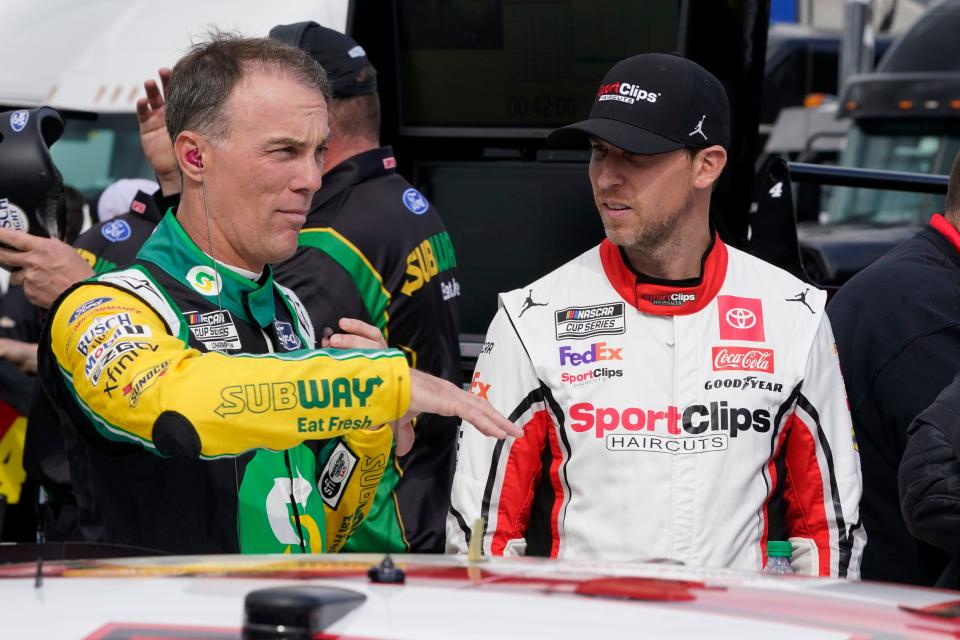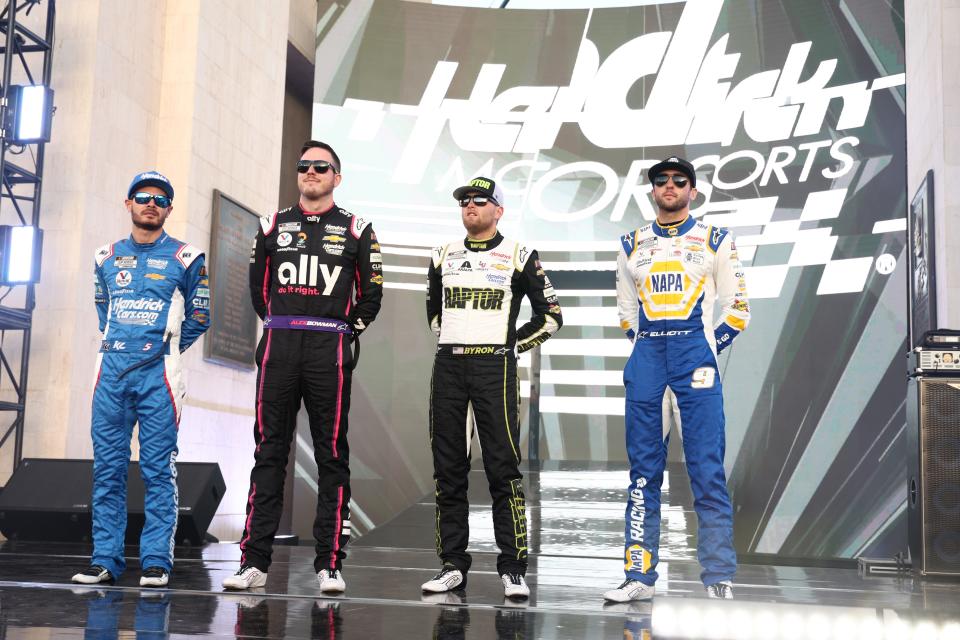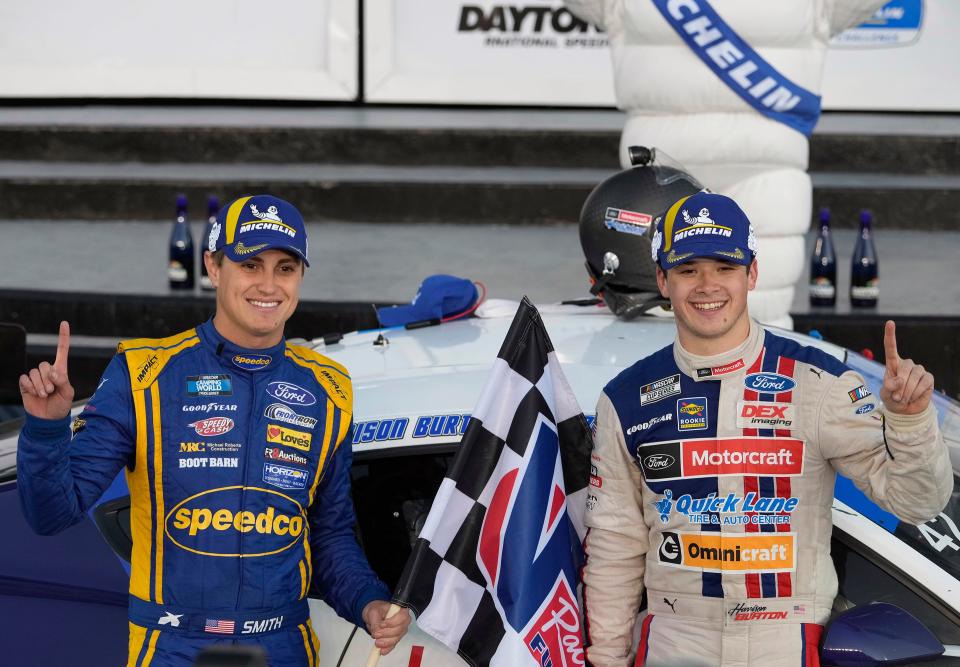Fixing NASCAR: Cup Series playoff format tweaks, an endurance race and Adriana Lima
The problem with all the criticism coming at NASCAR for falling TV ratings, the playoff format staleness, or the 2024 schedule, is that not many are coming up with answers.
But here at the News-Journal, we're solutions oriented. And while others went to social media, we went into the lab.
A couple of weeks of brainstorming and, voila, we've come up with some ideas that we think are polished enough to pitch. Will the folks at NASCAR listen? Who knows.
But at the very least, it gives us something to discuss in the dreaded dead season of stock-car racing and theoretically speaking, ideas of how future championships could be decided.
So, without further ado, here are some ideas we came up with to help.
'GREAT AMERICAN LOSS': Ken Squier, NASCAR narrator, voice of Daytona 500, dies at 88
The Harvick-Hamlin Hybrid Model

This one’s easy. Cut the field to two at Phoenix, one driver must drink a case of Busch Light before the race, the other must drive a FedEx Truck. Winner takes all.
No?
OK, try this.
Kevin Harvick appeared on the “Dale Jr. Download” following the Phoenix finale and bemoaned the fact that the championship comes down to just one race in the current format. Denny Hamlin made some waves this summer, suggesting a midseason, single-elimination tournament for prize money.
How bout we combine the two ideas? It would be easy to do.
Here goes: Expand the playoffs from 10 to 12 races. Most other current rules still apply — win and you’re in, drivers accrue playoff points that carry into each round of the playoffs and determine the standings entering the postseason. All of that.
But, instead of just cutting off the bottom four every three races, let’s seed the 16 entrants and then put them in a head-to-head bracket. The top driver entering the playoffs would square off against the 16th. No. 2 would face No. 15 and so on.
Each matchup would last three races with both drivers starting the round with their playoff points. The driver with the most points at the end of those three events, would move on to the quarterfinals with the losing drivers competing the rest of the way for spots nine-through-16. Come playoff time, wins would not guarantee advancement but drivers would continue to earn playoff points.
Each round would last three races leading to a three-race, championship finale between two drivers and instead of it being decided by the highest placement in one race, it would be points accumulated across three, stage points and playoff points included. Third place would also be determined with the rest of the positions in the top 16 sorting themselves out as well.
The Knockout Model
Adriana Lima hand chooses the NASCAR Champion. During an hour-long, season-ending broadcast.
Who says no?
Just imagine the ratings spike!
No, actually, in this model, all of the playoff drivers are randomly tapped on the shoulder and then punched in the face by Matt Crafton at some point during the season. The guy who takes the shot best, wins the title.
FINE.
In this format, instead of winners automatically getting into the postseason, last-place finishers are automatically out. Well, starting after the Daytona 500 anyway.
First, let’s make the Clash a little more interesting. Winner gets automatic entry into the playoffs. Also, the 500 is the Super Bowl of racing, right? So, let’s make it that important. The winner in Daytona is also automatically into the playoffs.
But starting from race two, all 36 drivers are alive but the lowest finisher of those remaining is, well, knocked out. While a win at a regular-season race doesn’t guarantee a playoff berth, it does provide a get-out-of-jail-free card.
If a driver has a win but finds himself in an elimination spot later in the season, he may turn in that win for reprieve from elimination. Instead, it would skip over him and eliminate the next-lowest-finishing driver.
And how about this for spicing up the All-Star race? The highest finisher among eliminated drivers is given a second chance and re-enters the field of drivers still alive. Also, the highest finisher in the regular-season points race among eliminated drivers at the end of the regular season is also given an exemption into the playoffs. Last year, that would’ve been Hamlin.
The postseason will encompass the final 10 races and could consist of anywhere between 12-14 drivers depending on the Clash and Daytona 500 winners. Last season, the playoffs would’ve included Hamlin, Ross Chastain, Kyle Larson, Brad Keselowski, Kyle Busch, Ryan Blaney, Martin Truex Jr., Christopher Bell, Bubba Wallace, Tyler Reddick, Ricky Stenhouse Jr. and Ryan Preece.
From there, wins start over at zero, but a win in the playoffs does provide another free pass from a future bad finish. Every week, the lowest finishing driver is eliminated until the finale, in which the highest finisher of those remaining wins it all.
Interestingly enough, we ran this model with last year’s results and ended up with the same four drivers still alive for the championship in Phoenix — Bell, Byron, Blaney and Larson.
The We're-in-this-Together Playoff Model

All the drivers on each team pile into one car and take a cross-country road trip, first team to navigate the trip from Boston to Los Angeles while obeying speed limits, observing traffic laws and fighting over restroom breaks/restaurant choices wins.
We also flirted with calling it the Griswold Method.
In actuality, the real system wouldn't be that far off. Before the season, each team would declare one car as being championship eligible. From there, team owners could move drivers and pit crew members around each week with the car, not the driver, accumulating points.
Think of it as setting a starting lineup for every race, like a baseball game. For example, we're sure it's not lost on Rick Hendrick that Chase Elliott is a road ringer. But is he as strong as Kyle Larson on intermediate tracks? Maybe, maybe not. But that would be a decision for Hendrick to make.
Does one crew chief come up with better strategy at a superspeedway than another? Want to sub out a tire changer midseason? Do it.
With 15 teams owning charters, that would leave 15 cars to count in the championship standings. All drivers not in one of those 15 cars would race for wins, pride and to impress the owner to get back in the seat.
An Endurance Race

Let’s be honest, once we put Cup cars on dirt, all bets were off, right?
We now have a street race, let’s take it one step further and incorporate some real teamwork along the way.
Let’s kill a run-of-the-mill spring or summer race, I vote the first Richmond event, and instead, pair drivers up for a 12-hour endurance event. The host track would cycle each year between the Indy Roval, Daytona Road Course, Road America and Canadian Tire Motorsports Park (NASCAR racin', eh?).
Team(s) | Possible drivers |
Hendrick Motorsports 1 | William Byron, Kyle Larson |
Hendrick Motorsports 2 | Chase Elliott, Alex Bowman |
Stewart-Haas Racing 1 | Chase Briscoe, Ryan Preece |
Stewart-Haas Racing 2 | Josh Berry, Driver TBD |
Joe Gibbs Racing 1 | Denny Hamlin, Martin Truex Jr. |
Joe Gibbs Racing 2 | Ty Gibbs, Christopher Bell |
Team Penske/Wood Brothers Racing 1 | Joey Logano, Ryan Blaney |
Team Penskey, Wood Brothers Racing 2 | Austin Cindric, Harrison Burton |
Trackhouse Racing | Daniel Suarez, Ross Chastain |
Richard Childress Racing | Kyle Busch, Austin Dillon |
Kaulig Racing | Daniel Hemric, Driver TBD |
23XI Racing | Bubba Wallace, Tyler Reddick |
Legacy Motor Club | Erik Jones, John Hunter Nemechek |
Spire Motorsports | Corey LaJoie, Carson Hocevar |
Spire Motorsports/JTG Daugherty Racing | Ricky Stenhouse Jr., Zane Smith |
RFK Racing | Brad Keselowski, Chris Buescher |
Front Row Motorsports | Michael McDowell, Todd Gilliland |
Rick Ware Racing | Justin Haley, Driver TBD |
There are 36 charters and by our quick math, that leaves 18 teams of two and the manufacturer breakdown works out perfectly. Hendrick Motorsports, Joe Gibbs Racing, Stewart-Haas Racing and Team Penske with the addition of the Wood Brothers No. 21 car, would each field two teams and could split their drivers however they like. JTG Daugherty Racing, a single-car Chevrolet operation, could join forces with the third Spire car.
With just 18 cars in the field, it takes away some of the sponsorship crunch for at least one week.
The race would be split into four shifts of three hours, with drivers alternating, driving around six hours total apiece. Teams would be afforded a 30-minute window at the end of each three-hour segment in which to pit and make driver changes.
With no stage breaks, the winning two drivers would receive 60 points and five playoff points, second place would get 51 points each and it would descend in gaps of three points from there.
This article originally appeared on The Daytona Beach News-Journal: NASCAR playoff fix: Beer runs are out, but check out these other ideas
